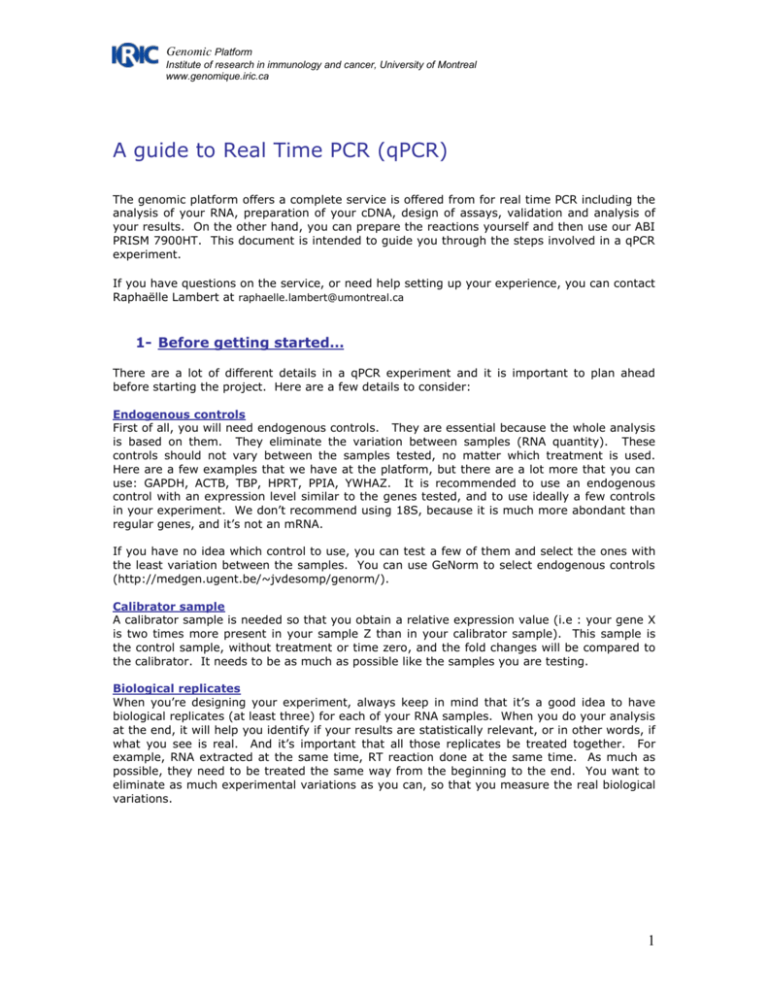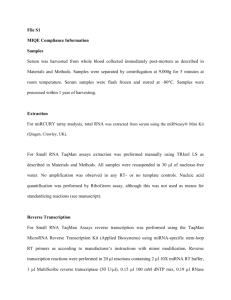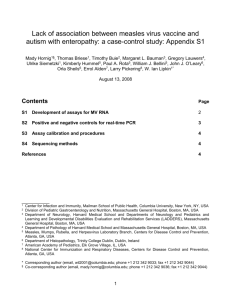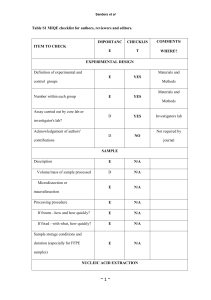Séquençage – Information et procédures
advertisement

Genomic Platform Institute of research in immunology and cancer, University of Montreal www.genomique.iric.ca A guide to Real Time PCR (qPCR) The genomic platform offers a complete service is offered from for real time PCR including the analysis of your RNA, preparation of your cDNA, design of assays, validation and analysis of your results. On the other hand, you can prepare the reactions yourself and then use our ABI PRISM 7900HT. This document is intended to guide you through the steps involved in a qPCR experiment. If you have questions on the service, or need help setting up your experience, you can contact Raphaëlle Lambert at raphaelle.lambert@umontreal.ca 1- Before getting started… There are a lot of different details in a qPCR experiment and it is important to plan ahead before starting the project. Here are a few details to consider: Endogenous controls First of all, you will need endogenous controls. They are essential because the whole analysis is based on them. They eliminate the variation between samples (RNA quantity). These controls should not vary between the samples tested, no matter which treatment is used. Here are a few examples that we have at the platform, but there are a lot more that you can use: GAPDH, ACTB, TBP, HPRT, PPIA, YWHAZ. It is recommended to use an endogenous control with an expression level similar to the genes tested, and to use ideally a few controls in your experiment. We don’t recommend using 18S, because it is much more abondant than regular genes, and it’s not an mRNA. If you have no idea which control to use, you can test a few of them and select the ones with the least variation between the samples. You can use GeNorm to select endogenous controls (http://medgen.ugent.be/~jvdesomp/genorm/). Calibrator sample A calibrator sample is needed so that you obtain a relative expression value (i.e : your gene X is two times more present in your sample Z than in your calibrator sample). This sample is the control sample, without treatment or time zero, and the fold changes will be compared to the calibrator. It needs to be as much as possible like the samples you are testing. Biological replicates When you’re designing your experiment, always keep in mind that it’s a good idea to have biological replicates (at least three) for each of your RNA samples. When you do your analysis at the end, it will help you identify if your results are statistically relevant, or in other words, if what you see is real. And it’s important that all those replicates be treated together. For example, RNA extracted at the same time, RT reaction done at the same time. As much as possible, they need to be treated the same way from the beginning to the end. You want to eliminate as much experimental variations as you can, so that you measure the real biological variations. 1 Genomic Platform Institute of research in immunology and cancer, University of Montreal www.genomique.iric.ca 2- RNA preparation You have to perform your own total RNA extraction. When extracting RNA from cells or tissue, an RNA extraction protocol using Trizol or using a column usually works well. RNA extraction from some tissues can be tricky, and sometimes Trizol extraction should be followed by a column. Find out if your tissue requires specific handling. No inhibition If you’re extracting RNA with Trizol, you have to be very careful as to not carry any phenol over when transferring the supernatant after centrifugation. Solvents can inhibit the Reverse Transcription reaction and the PCR reaction. Always take less and leave some behind. When quantifying your RNA with the spectro, make sure you have a good OD 260/280 ratio between 1.8 and 2 and OD 260/230 ratio of 1.8 or greater. Nucleic acid is detected at 260nm, whereas protein, salts and solvents are detected at 230 and 280nm. No degradation It is absolutely essential that your RNA be of good quality. No degradation is acceptable. If your RNA is degraded, it will be in small pieces. The PCR may still amplify because the qPCR assays are small (60-150pb), but degradation introduces bias that are not acceptable. We recommend migrating your RNA samples on gel or analysing them on our Bioanalyzer (fig 1). You need to see two bands: 28S and 18S subunits (and no other band). Good quantity Always quantify your RNA (spectro, nanodrop) before bringing it to the platform or perform your RT reaction. The quantity of RNA needed is approx. 25ng for each individual PCR reaction. For example: 5 samples to test with 10 genes + 2 endogenous controls: 12 genes x triplicata = 36 reactions 36 reactions x 25ng = 900 ng of RNA per sample Fig 1. Migration of RNA samples on a Bioanalyzer from Agilent 2 Genomic Platform Institute of research in immunology and cancer, University of Montreal www.genomique.iric.ca 3- cDNA synthesis from total RNA Before doing the qPCR itself, you need to transcribe the RNA into cDNA. reaction, done with a reverse transcriptase. It’s an enzymatic We are using the « High Capacity cDNA Reverse Transcription Kit » from Applied Biosystems. The RT reaction is done with random primers, which are degenerate primers that will bind everywhere. RT reaction using an oligo dT is not recommended since assays near the polyA tail of the mRNA will be favored and it could introduce bias. We recommend doing a sample noRT (no Reverse Transcriptase). This sample will contain RNA and all ingredients except the reverse transcriptase. This sample should be negative/no amplification or a very late amplification (35 cycles and more). But if it’s contaminated with genomic DNA, it will amplify (for the assays that are not inter-exon). Ideally, all assays are made so as to not detect genomic DNA (inter-exon), but sometimes it’s impossible to do a inter-exon assay, and the presence of DNA is not wanted anyway. You can treat your RNA with DNase if it’s contaminated. Prepare a RT reaction for what you need. With 2ug of RNA you can test up to 20 genes, and with 5ug you can test up to 60 genes Protocol for the RT according to the quantity of RNA needed : Composantes 2ug 5ug 10ug 10X Reverse Transcript Buffer 2 µl 5 µl 10 µl 10X Random primer 2 µl 5 µl 10 µl 25X dNTPs 0.8 µl 2 µl 4 µl MultiScribe Reverse Transciptase enzyme (50U/µl) 1 µl 2.5 µl 5 µl H2O Nuclease free 4.2 µl 10,5 µl 21 µl RNA 10 µl 25 µl 50 µl Total 20 µl 50 µl 100 µl Incubate your samples 10 minutes at room temperature and then 2 hours at 37°C. When the reaction is over, you can keep your samples at -20°C. 3 Genomic Platform Institute of research in immunology and cancer, University of Montreal www.genomique.iric.ca 4- Design of qPCR assay You will need a qPCR assay for each gene that you want to test. There are two technologies commonly used: SYBR green and Taqman. SYBR Green is a DNA intercalant, so it will detect everything double stranded, while Taqman works with a gene specific fluorescent probe. We prefer using Taqman because less fine tuning is required when you setup an assay, and it’s more specific. But both technologies are good. At the Genomic Plateform, we have the complete library of UPL probes (Universal probe library from Roche) for human and mouse (#1 to #110). It is possible to use these probes for assays on other species. This technique is based on the TaqMan principle except that the length of the probe is limited to 8 nucleotides (some chemical additives are present to increase the Tm of the probe). Therefore, these small probes can hybridized at many places on the genome but when the assay is combined with specific oligonucleotides, the assay becomes very sensitive and specific. With this library, we can detect 99% of the genome (human and mouse). If you are at IRIC and you want to do your assays yourself, you can use our library of UPL probes, and pay by the reaction. If you are not at IRIC and you want to do your own assays, we suggest using SYBR green because the price of an individual gene specific Taqman probe is quite high (around 125$ per gene). Designing a SYBR green assay follows the same recommendations as a Taqman assay, except there is no probe, and the qPCR mix to use in the final reaction needs to contain SYBR Green. Oligo Fwd Fluorescent probe Oligo Rev Fig2. Taqman qPCR assay A Taqman qPCR uses two gene specific oligonucleotides and a specific fluorescent probe. During amplification of the amplicon, the probe is degraded by the Taq polymerase and fluorescence is emitted. Without amplification, the fluorescence (pink) is quenched by the quencher (blue) and is not emitted. To design your qPCR assay with the UPL library, follow this link: www.universalprobelibrary.com Here are a few recommendations: - - Length between 60 and 150 bp Select an assay that is located between two exons or even better, select an assay where one of the primer or the probe is located at the exon-exon junction. The intron has to be 500 bp or more to avoid its amplification if your sample contains genomic DNA. The program indicates the position of the introns with a triangle. Note the sequence of your primers and the probe number (#1 to #110) 4 Genomic Platform Institute of research in immunology and cancer, University of Montreal www.genomique.iric.ca 5- Standard Curve to validate the assays For each assay, you need to do a standard curve to verify three things: 1- Is the assay working? 2- Is the gene present in my samples? 3- Is the efficiency of the PCR at 100%? First, you can resuspend your oligos at a stock concentration of 100 uM. Then, mix these two primers to obtain a final concentration of 50uM (for example: take 25 ul of primer A and 25 ul of primer B). To make a standard curve, you need to do 4 serial dilutions: 1:5, 1:25, 1:125 and 1:625. This experience can be done in technical duplicates. It’s recommended to do the dilutions with cDNA (or a mixture of many cDNA) similar to the ones that will be used in your real experiment. If it’s not possible, you can use a universal cDNA (including several tissues of the same specie). It’s important that you always use a diluted cDNA (no undiluted for the first point of the curve). The RT solution contains PCR inhibitors and when they are present at a higher concentration they inhibit the qPCR reaction. How do I know if my assay is good? 1- General aspect of the PCR curves Your assay needs to come out at a respectable cycle (generally around 20-25). If your gene comes out at a very late cycle (30-35), there is a big chance that your results will be of bad quality. You need to see at least 3 points of your curve, the duplicates need to be nice and together and the curves need to be clean and not frizzled. 2- Slope of the standard curve The slope of the standard curve should ideally be -3.33 (which corresponds to an efficiency of 100%). In practice, we accept a slope between -3.1 and -3.6 (90 to 110%). What you need is to have a similar efficiency for all the genes that you test. For example, your test gene and your endogenous gene need to have approximately the same efficiency because you will compare those genes together. If an assay is not efficient enough, it will come out a little bit later then the others and it can make a difference in your final results. A difference of 1 cycle already equals a fold change of 2. If the slope of the standard curve does not fall within an acceptable interval, it is suggested to do the curve a second time and if the results remain the same, a new assay has to be designed and ordered. If you only have 1 or 2 genes, you can order 2 assays the first time to make sure one of them is good and save time. 5 Genomic Platform Institute of research in immunology and cancer, University of Montreal www.genomique.iric.ca Examples of Standard Curve runs Perfect! Slope of de -3.3 Very low efficiency, around 70% Here, the curves are coming out too late. The curves are not nice and the duplicates are not together. Either the oligos are not working well, or the gene is not expressed at a sufficient level. 6 Genomic Platform Institute of research in immunology and cancer, University of Montreal www.genomique.iric.ca Range of acceptable efficiencies when testing a new qPCR assay. Slope Amplification Efficiency (%) -3.60 -3.55 -3.50 -3.45 -3.40 -3.35 -3.30 -3.25 -3.20 -3.15 -3.10 1.8957 1.9129 1.9307 1.9492 1.9684 1.9884 2.0092 2.0309 2.0535 2.0771 2.1017 89.57 91.29 93.07 94.92 96.84 98.84 100.92 103.09 105.35 107.71 110.17 Amplification = 10(-1/slope) Efficiency = [10(-1/slope)] – 1 7 Genomic Platform Institute of research in immunology and cancer, University of Montreal www.genomique.iric.ca 6- How to do a qPCR reaction All qPCR reactions should be done in triplicate for each sample and all genes. We use 384 wells plate and a final volume of 10 ul. Do not forget to add the noRT control and the NTC control (no template control : replacing cDNA with water). It is important to dilute the RT reaction (min 1:2, max 1:10) since RT reagents can inhibit qPCR reaction. The PCR Master Mix for qPCR is Taqman Fast qPCR MasterMix from Applied Biosystems (Roche, Qiagen and Invitrogen are also recommended). The qPCR mix « fast » allows us to use a faster qPCR program which takes 1h instead of 1h30 (40 cycles). Protocol for Roche assays with UPL probes: Reactives 1 reaction initial [ ] final [ ] 2X PCR Master Mix 5 µl 2X 1X Primer (A and B) 0,05 µl 50 µM 250 nM UPL primer (diluted1/10) 1 µl 1 µM 100 nM cDNA (between 5-25ng) 1.5 µl --- --- H2O 2.5 µl --- --- Total 10 µl Protocol for Taqman gene expression assays (endogenous controls) Reactives 1 reaction 2X PCR Master mix 5 µl TaqMan assay (20X) 0.5 µl cDNA (between 5-25ng) 1.5 µl H2O 3 µl Total 10 µl FAST and regular qPCR programs 40 cycles 95°C 95°C 60°C Fast 3 min 5 sec 30 sec Regular 10 min 15 sec 1 min 8 Genomic Platform Institute of research in immunology and cancer, University of Montreal www.genomique.iric.ca 7- Result analysis of qPCR results Q-PCR measures the intensity of fluorescence emitted by each well, at each cycle. During the first cycles, there is not enough fluorescence to be detected, but the reaction rapidly produces more and more amplicons and the fluorescence builds up. A qPCR curve has typically an exponential phase followed by a plateau phase. The Ct measure needs to be taken in the exponential phase, where the curve is linear. Definitions of the terms found in the excel sheet Ct = PCR cycle A typical qPCR run has around 40 cycles. The Ct is the value where the PCR curve crosses the threshold, in the linear part of the curve. It’s the value that will be used for the analysis. The higher the Ct (30-35), the less the mRNA detected is present, because you need more cycles of amplification to detect the fluorescence. If the Ct has a small value (10-15), the gene is highly expressed. Endogenous controls typically have a smaller Ct then regular genes. Delta Ct = Ct gene test – Ct Delta Delta Ct = ∆Ct endogenous control sample1 – ∆Ct calibrator Delta Ct SD = Standard Deviation The standard deviation is calculated by the software with the delta Ct value of the technical triplicates. The triplicates are valid when the SD is smaller then 0.25. If the SD is over 0.25, the RQ value is considered unreliable. RQ = Relative quantification = 2-∆∆Ct The RQ is your fold change compared to the calibrator (untreated sample, time zero, etc.). The calibrator has a RQ value of 1. All samples are compared to the calibrator. A RQ of 10 means that this gene is 10 times more expressed in sample x then in the calibrator sample. A RQ of 0,1 means that the gene is 90% less expressed. We consider significant a two-fold change: RQ of more then 2 or less then 0,5. To put these values into a graph, use a log scale. Or you can transform the values of RQ<1 in negative values using the -1/RQ formula. Interesting article on qPCR method for publication The MIQE guidelines: minimum information for publication of quantitative real-time PCR experiments. Bustin SA, Benes V, Garson JA, Hellemans J, Huggett J, Kubista M, Mueller R, Nolan T, Pfaffl MW, Shipley GL, Vandesompele J, Wittwer CT. Clin Chem. 2009 Apr;55(4):611-22. Epub 2009 Feb 26 9 Genomic Platform Institute of research in immunology and cancer, University of Montreal www.genomique.iric.ca Do the curve analysis yourself Download the software (genomique.iric.ca). SDS 2.2.2 available in your account on the website When we run a qPCR plate with the 7900HT machine, the software creates an .sds file with the raw data. 1. Open the .sds file and click on the green arrow on top. The software will analyse the results. 2. In the tab Setup, verify that the sample names and the gene names are correct. Verify that the endogenous controls are identified as controls in the section « Task ». Close this file. 3. Open a new file : Relative Quantification (delta delta Ct) Study 4. At the bottom right, click on Add Plate. Choose the .sds file you want to analyse and add it to the study. 5. Click on the green arrow. 6. Click on the Results tab at the top right of the window to visualise the results. 7. At the top of the window, unclick the graph icon to see only the PCR curves. 8. Start with the first gene. Select the wells corresponding to the gene in the colourful plate on the left, and then select the gene in the dropdown list at the bottom of the graph. PCR curves should appear. 9. Place the Baseline, it should end just before the first curve. Use the small red arrow at the bottom of the graph. 10. Move the threshold in the linear part of the curves (red line in the middle of the graph). Note: The baseline and the threshold are specific to each gene. It is important to make sure that only one gene at a time is selected in the dropdown list. 11. Verify your triplicatas. If there is one outlier, you can take it out of the analysis. Select the well you want to take out, come back to the Setup tab and click Omit Well. This value will not be considered in the analysis. Note: if you have more then one plate in your study, be careful when you take out a well. Wells that you select in different plates can superpose and everything selected will be taken out. You could take out wells that you want to keep. 12. After every modification, always click on the green arrow to get the new analysis. 13. Now click on the small green arrow to get to the analysis parameters. Select your endogenous control and your calibrator sample. If you need detailed raw data with individual Ct values, click on Individual Ct. 14. In the File menu, select Export. The software will export a .txt file, that you can open in excel. 10








